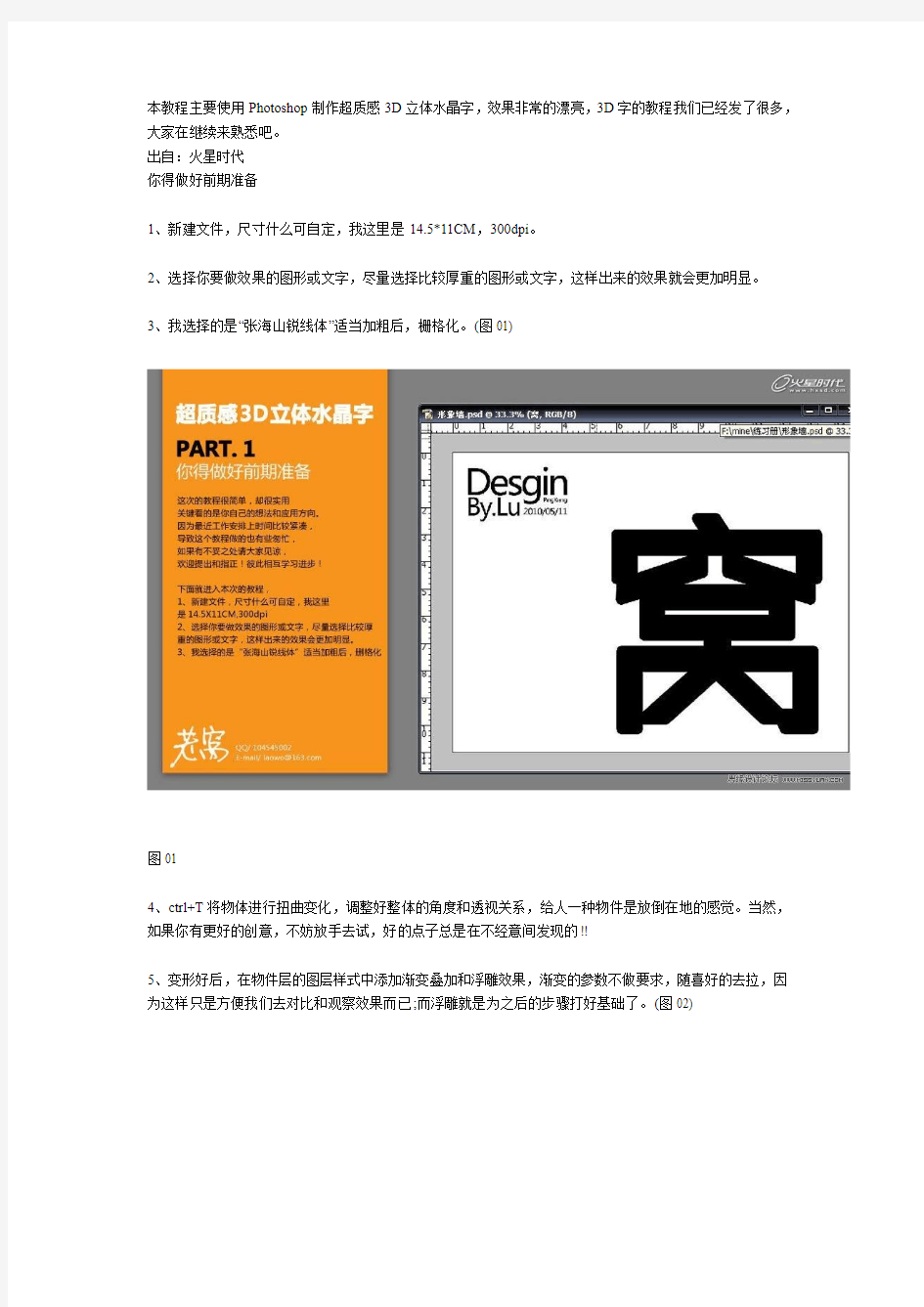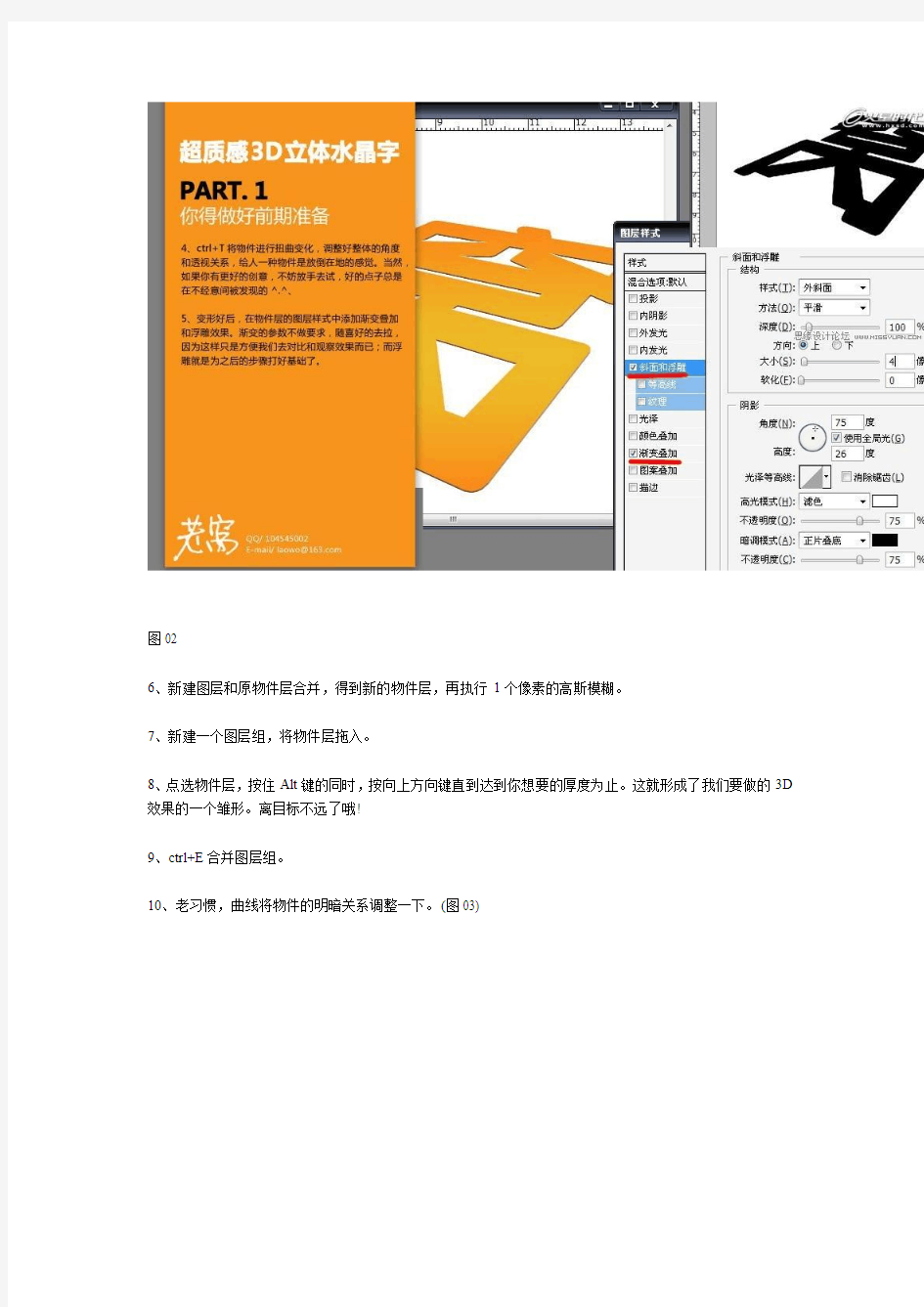超质感3D立体水晶字


本教程主要使用Photoshop制作超质感3D立体水晶字,效果非常的漂亮,3D字的教程我们已经发了很多,大家在继续来熟悉吧。
出自:火星时代
你得做好前期准备
1、新建文件,尺寸什么可自定,我这里是14.5*11CM,300dpi。
2、选择你要做效果的图形或文字,尽量选择比较厚重的图形或文字,这样出来的效果就会更加明显。
3、我选择的是“张海山锐线体”适当加粗后,栅格化。(图01)
图01
4、ctrl+T将物体进行扭曲变化,调整好整体的角度和透视关系,给人一种物件是放倒在地的感觉。当然,如果你有更好的创意,不妨放手去试,好的点子总是在不经意间发现的!!
5、变形好后,在物件层的图层样式中添加渐变叠加和浮雕效果,渐变的参数不做要求,随喜好的去拉,因为这样只是方便我们去对比和观察效果而已;而浮雕就是为之后的步骤打好基础了。(图02)
图02
6、新建图层和原物件层合并,得到新的物件层,再执行1个像素的高斯模糊。
7、新建一个图层组,将物件层拖入。
8、点选物件层,按住Alt键的同时,按向上方向键直到达到你想要的厚度为止。这就形成了我们要做的3D 效果的一个雏形。离目标不远了哦!
9、ctrl+E合并图层组。
10、老习惯,曲线将物件的明暗关系调整一下。(图03)
图03
11、这个时候,大家可以仔细观察一下整个物件的细节,明暗和立体效果等。那谁说的,知己知彼,方百战不怠嘛。
12、开始前,建议大家另存一个物件副本隐藏,以防做坏了无法恢复。
13、在物件层上新增一个图层,填充正红色,ctrl+G叠入物件层中,图层模式改为“颜色加深”再将这两层
合并备用。(图04)
图04
14、到这里我又用曲线工具调整了一下物件的明暗。
15、放大物件后,大家可能也发现了,立体部分有比较明显的叠加痕迹。我们用涂抹式的模糊工具处理后,再执行锐化边缘,次数可自己控制。
16、COPY物件层,执行素描中的铬黄,参数如图。(图05)
图05
17、将其图层模式改为“点光”,透明度为30%。
18、执行USM锐化,大概15左右就好...
19、合并图层20、选择局部高光区域进行细化。
21、再使用加深工具强化边角暗处。这里要注意参数的设置,20%,最大化虚化笔刷边缘。(图06)
图06
22、在物件右上角,选出光源区域,新建图层填充明黄色,ctrl+G,柔光模式。适当调整透明度。我这里用了两个高光层,一个是右上角,一个是右半部分.自己看情况哦...
23、合并图层。(图07)
图07
PART.3
为自己鼓掌吧!
24、OK...快接近尾声了...加油!
新建层,给物件做出投影,使立体效果更加逼真。使用笔刷工具,沿着物件边缘刷出投影效果,由深到浅的晕染出去,参数如图:(图08)
PS:记住右上角是光源,要注意物件的投影方向...
图08
25、最后,为物件适当润色,加上自己的LOGO就大功告成了。(图09)
PS:最后一步也可以在物件层上新建图层填充自己喜欢的颜色,点选图层模式为“颜色”,哈哈,效果挺不错的,总之,你的地盘你做主!为自己鼓掌吧!!!恩恩...老窝大人要退场咯,大家下次见吧!再一次,谢谢大家!
^.^
利用红蓝分色原理制作三维图片及三维视频
实验二 一、问题描述 根据人眼三维视觉形成的原理,利用红蓝分色原理制作三维图片与三维视频。 二、问题分析 三维图像: 步骤: 1.利用手机/相机等摄像设备,拍摄大小相同的左眼图与右眼图 2.利用OpenCV读入左眼图与右眼图,假设左眼图像第i个像素颜色向量为(R1_i,G1_i,B1_i); 右眼图像第i个像素颜色为(R2_i,G2_i,B2_i),则合成后的立体图像第i个像素为(R1_i,G2_i,B2_i);利用OpenCV显示并保存合成后的图像 3.利用红蓝眼镜观察立体效果是否明显,如果不明显,请重复1~2 难点: 在拍摄左眼图与右眼图时有技巧:由于人的两眼间存在一个不足 5 厘米的间距,因此在盯住同一景物时,两个眼球的角度并不相同。因此我们的拍摄也必须模拟这一原理,对同一景物拍摄两张照片,而且拍摄时需要略微变换一下拍摄角度(这个角度很小,约5~10 度)。其次为了达到更好的合成效果,目标最好选择一些前背景比较分明的景物,如果能用单反拍摄出背景虚化的照片就更好。
三维视频: 利用拍摄图片的方法拍摄左眼视频与右眼视频,然后利用OpenCV读取左眼与右眼视频中的每一帧图像,利用上述方法合成三维图像,并利用OpenCV保存成.avi格式的视频。 难点:如何保持左眼视频与右眼视频在时间上的同步 三、详细设计(从算法到程序) 1.主模块设计 三维图片: #include"iostream" #include"cmath" using namespace std; using namespace cv; int main() { Mat left = imread("211.jpg");//加载图片
3D彩色透视图(男人都喜欢
3D彩色透视图(男人都喜欢 3D彩色透视图(男人都喜欢) 苏一木发表在军事贴图华声论坛https://www.wendangku.net/doc/1517001108.html, 3D彩色透视图screen.width*0.7) this.width=screen.width*0.7;" title="" alt=按此在新窗口浏览图片 src="https://www.wendangku.net/doc/1517001108.html,/DownloadImg/2010/04/1601/28 82266_2.jpg" onload="if(this.width>screen.width*0.7) this.width=screen.width*0.7;" border=0>screen.width*0.7) this.width=screen.width*0.7;" title="" alt=按此在新窗口浏览 图片 src="https://www.wendangku.net/doc/1517001108.html,/DownloadImg/2010/04/1601/28 82266_3.jpg" onload="if(this.width>screen.width*0.7) this.width=screen.width*0.7;" border=0>screen.width*0.7) this.width=screen.width*0.7;" title="" alt=按此在新窗口浏览 图片 src="https://www.wendangku.net/doc/1517001108.html,/DownloadImg/2010/04/1601/28 82266_4.jpg" onload="if(this.width>screen.width*0.7) this.width=screen.width*0.7;" border=0>screen.width*0.7) this.width=screen.width*0.7;" alt=按此在新窗口浏览图片 src="https://www.wendangku.net/doc/1517001108.html,/DownloadImg/2010/04/1601/28 82266_5.jpg" onload="if(this.width>screen.width*0.7)
红蓝3D成像原理
红蓝3D成像原理 人类是通过左眼和右眼所看到的物体的细微差异来获得立体感的,要从一幅平面的图像中获得立体感,那么这幅平面的图像中就必须包含具有一定视差的两幅图像的信息,再通过适当的方法和工具分别传送到我们的左右眼睛。 图像中的任何一个象素的颜色都可以由一组RGB值来记录和表达,图像上所有的颜色,都是由这些红绿蓝三种色按照不同的比例混合而成,这红色绿色蓝色又称为三原色,三原色中任何一色都不能用其余两种色彩合成。RGB的所谓“多少”就是指亮度,通常情况下,RGB 各有256级亮度,用数字从0、1、2...直到255来表示。按照计算,256级的RGB色彩总共能组合出约1678万种色彩,即256×256×256=16777216。通常简称为24位色。纯黑的RGB值0,0,0;纯白的RGB 值是255,255,255;纯红的RGB值是255,0,0。纯绿的RGB值是0,255,0;纯蓝的RGB值是0,0,255。纯黄的RGB数值是255,255,0,可以看出:
纯黄色=纯红色+纯绿色,根据互补色原理,补色指完全不含另一种颜色,红和绿混合成黄色,因为完全不含蓝色,所以黄色就是蓝色的补色。我们可以通过计算来确定任意一个颜色的互补色:首先取得这个颜色的RGB数值,再用255分别减去现有的RGB值即可。比如黄色的RGB值是255,255,0,那么通过计算:r(255-255),g(255-255),b(255-0),互补色为:0,0,255。正是蓝色。红色的互补色为青色,红色的RGB值是(0--255),0,0;而青色的RGB值是0,(0--255),(0--255),由于它们不含有对方的颜色,利用这个特点,用红色来保存一幅图像的信息,而用青色来保存另一幅图像的信息,这样就完全可以用一幅图像来包含两幅图像的信息了。我们可以用一个公式来表达;第一幅图像RGB1=R1,G1,B1;第二幅图像RGB2=R2,G2,B2,合成后的立体图像RGB12=R1,G2,B2或RGB21=R2,G1,B1。从公式RGB12=R1,G2,B2中可以看出,合成后的立体图像实际上包含了第一幅图像的红色RGB=R1,0,0和第二幅图像的青色RGB=0,R2,B2。 接下来的问题就是怎样保证我们的左右眼分别只看到一幅图像,研究一下立体眼镜,红色眼镜片的RGB值是255,0,0;青色眼镜片的RGB 值是0,255,255,因为只有红色才能透过红色眼镜片,传送到我们左眼的图像的RGB红=R1,0,0;因为只有青色才能透过青色眼睛片,传送到我们右眼的图像的RGB青=0,R2,B2。这样包含在一幅红蓝立体图中的两幅图像的信息就被分别传送到了我们的左右眼睛。
简易3D红蓝眼镜的制作方法
简易3D红蓝眼镜的制作方法 最近几天迷上了3D技术,从网上下了好多3D图片和3D 高清电影,还买了几副3D红蓝眼镜,因为这是看3D电影必不可少的工具。不过3D技术其实并不神秘:人们在现实生活中看到的东西为什么会有立体的感觉?那是因为我们的两只眼睛之间有一小段距离,看东西的角度不同,看到的图像事实上是不一样的,而正是这种不同造成我们视觉中的立体感。3D 红蓝眼镜的原理与其相似,就是用左边的红色镜片滤掉特制的3D电影或图片的蓝色部分,用右边的蓝色镜片滤掉其红色部分,这样两只眼睛就看到了不一样的东西,就有了立体的感觉。 明白了3D眼镜的原理,我们就可以自己制作简易的红蓝眼镜了。只要牢牢记住一点就可以:左边的镜片用红色,右边的镜片用蓝色。至于用什么制作镜片,你可以就地取材,废物利用。镜片可以用玻璃片、硬塑料纸、饮料瓶等等,最好是本身带有红蓝颜色的,如果是透明的不带颜色的,我们可以想办法自己上色,比如可以用红蓝两色的油性记号笔涂抹等等。今天早上闲来无事,自己用家里的材料制作了一对简易的红蓝镜片,试了试效果还不错,现将具体方法拿来与各位共飨之。 首先,我把在上大学时用过的考试证外面的两层塑料硬膜给揭了下来(嘿嘿,废物利用,低碳环保~~),用剪刀剪成两个眼镜片。之所以用考试证上的塑料硬膜,是因为家里没有别的合适的材料,塑料纸太软,饮料瓶太不平整,玻璃片还在窗户上装着呢,舍不得毁掉。 其次,我用家里的油性记号笔(本人喜欢画画,这些东西少不了)在两个塑料眼镜片上分别涂上红蓝两色,待其晾干以后,用双面胶粘在我的近视镜上,便大功告成了。这一歩要注意的是:找颜色时尽量找那种深红色和正蓝色;涂的时候着色尽量均匀,不要出现一道一道的痕迹。我是近视眼,可以把镜片贴在我的近视镜外面,不需要做镜框。各位要是不近视的话,可以用硬纸片自己制作一个简易镜框,方法简单,恕不赘述。当然,你要只是试验的话,不要镜框手拿着镜片看一会儿也无妨。
3D红蓝图制作(英文版)Jan_05web
I f you have ever wondered what it is like to be a self published photographer, wait a month till he’s not so frazzled, then ask Gre g Marshall. Greg has been working on the images, the text, the layout, chosing a printer, and fi ne tuning the fi nal production of his fi rst book, The Classic Nude in 3D . Classic Nude was published the end of December 2004 and the fi rst sales are in progress. The 3D Center gift shop and online store will be selling the book. Orders have already come from Japan and several U.S. states. As if this does not keep him busy enough, Greg is the featured artist at the Center in January and February. He has mounted 12 stereo pairs from his classic nude collection for the exhibition. On January 6 (First Thursday), the Center will host a public artist reception for Greg from 6 - 9pm. Marshall has been an active amateur photographer for more than 35 years while making a living as an electrical engineer. He began making stereoscopic images about 10 years ago. He studied graphic arts in high school over the protests of the head of the mathematics Cooperative, which he co-founded in 2000, and is a board member of the Cascade Stereoscopic Club of Portland. He has exhibited in numerous community art shows in California and Oregon and hopes to expand his photographic activity upon retirement. Greg’s wife is also a visual artist, working in watercolor and mixed media. They have two grown children. A large portion of their Canby home is devoted to studio space. You can see more of his work on his website: https://www.wendangku.net/doc/1517001108.html,/gbmarshall CENTER NEWS Published by 1928 NW Lovejoy Street, Portland, OR 97209 Man’s Best Friend, Santa and the 3D Center The Classic Nude in 3D : An Exhibit and a Book Artist’s Statement by Greg Marshall My photographic journey began at age fourteen when my oldest brother (who was my role model) started taking pictures and built a darkroom in our home. My interest was reinvigorated twelve years ago when it became practical to “process” images on a computer. Although I love the artistic and technical aspects of fi ne print making, the dark, smelly environment of the traditional darkroom never appealed to me. So now I work entirely with digital images using a digital SLR camera, archival inkjet printer, and fi lm recorder. My mother tells me that as a small child I was the favorite of all the ladies in the neighborhood because of my easy-going, friendly nature. I’m sure I’ve changed since then, but perhaps that was the beginning of a life in which women have always played an important role; from my mother, who was totally devoted to her children; to my sisters, who taught me about music and many other things; my wife, who brought out the artist in me; and my daughter, who continues to keep me young at heart. So for the past year I have turned my attention away from my usual photography of still lifes to work on a series of images that would portray strength, courage, passion and beauty of woman. Stereo photography is both a challenge and an asset in this endeavor, but I hope you’ll agree that the images selected for this show demonstrate a three-dimensional aesthetic that goes beyond the simple sense of realism that is the power of most stereo photographs. You may notice that some of my images resemble those of Ruth Bernhard, one of my favorite photographers, including one specifi cally crediting her, “Homage to Ruth.” Her work shows a great talent for two-dimensional design and was my inspiration for the idea of abstract design in three-dimensional space. department because the class schedule confl icted with the top math class. In college he took photography and other art courses while majoring in communications, and later earned a Master of Science degree in computer science. His career as an electrical engineer spans more than 25 years. He has worked primarily with various types of imaging systems, including computer graphics, video, medical imaging, and printing systems. Born and raised in Vermont, Greg’s career took him to California, where he was a co-founder in several high-tech companies, and fi nally, to Oregon. He has been active in several photography clubs, including the AfterLight Photo The Center’s fi rst 8 week beginner’s class in stereo photography netted four students, Claire Dean, Jim McMahon, Lisa Metzger, and Colin Johnson. Lisa and Colin were non CSC members and totally new to 3D. The result was two new local members, a great program at the Novem-ber CSC meeting where they showed cards and slides they had created, and a new editor for Stereo Views (Colin). So, do you think we are going to do it again? You bet!! See the sched-ule of upcoming classes on page 2 or check the website for more information. Photo: Shab Levy Ted Welker had the Santa Claus suit and the Ho, Ho, Ho, and we had the Amazing Human in 3D system from the Netherlands – it was a natural. There wasn’t much time to advertise, but we got an ad in the Oregonian and one in Willamette Week. On Sunday, December 12, anyone could come to the 3D Center and have their picture taken with Santa Claus in 3D. Several people took us up on the offer. Elwood and Jackie pictured to the right brought their dogs, Ted-e, Chris, Darwin, Hal and Jack to create a family portrait with Santa. The images were put into a collapsible viewer with lenses which could be mailed in a regular envelope or saved as a souvenir. One picture and viewer was $5 and you could get a second image and viewer for $3 more. What a deal! People loved it and next year we will start earlier and promote it more. On our one day of Santa in 3D, we sold $93 worth of pictures and the volunteers had a great time. Fieldtrips, Classes and Workshops In September 2004, the Center offered the fi rst 8 week beginning stereo photography course. The course, taught be Shab Levy, was advertised in Willamette Week. The result was an enrollment of 4 people, two of whom had no exposure to 3D photography and two of whom were CSC members hoping to take more stereo images and to get better results with tips learned in the class. During the November CSC meeting, the students displayed stereocards and slides that they made during the 8 week course. It was impressive. The Center also hosts groups by special arrangement. The charge for a special opening is $50. We have had several student groups and one photography club. Groups of students have been divided in two with the fi rst half taken to the stereo theatre and the second half shown the displays, featured artist, gift shop and other exhibits. The groups then reverse. At the end of their visit the students are gathered together and given a talk about how stereo photography works, the various means of viewing 3D, and how one can begin creating 3D images with a simple camera. During the fall we had 2 student groups. Twenty-two students from the TAG (Talented and Gifted) program in Lake Oswego toured the Center in November. They were middle school students and they had great questions and a lot of enthusiasm for the things they saw. They especially enjoyed the slide show, Art in Depth . In the coming year, we will encourage more special groups, classes and workshops.
- 立体眼镜-红蓝3D眼镜
- 左右格式上下格式3D电影转换红蓝格式3D电影教程
- 百张经典3D图片欣赏
- 教你如何挑选3D眼镜3D分色测试图(实用教程)
- 红蓝3D眼镜常见问题
- 3D红蓝图制作(英文版)Jan_05web
- 3D红蓝图片
- 乳腺3D解剖超高清图谱-你值得拥有
- 普通电脑怎么在线观看红蓝3D电影
- 红蓝高清图片欣赏
- 利用红蓝分色原理制作三维图片与三维视频
- 用红蓝眼镜观看偏振格式3D影片的方法
- 红蓝3D成像原理
- 如何使用i3D Photo制作红蓝3D立体图片
- 3D小动物图片高清素材(115个)
- 3D彩色透视图(男人都喜欢
- 简易3D红蓝眼镜的制作方法
- 百张经典3D图片欣赏
- 利用红蓝分色原理制作三维图片及三维视频
- 3D红蓝电影转左右偏振电影教程
